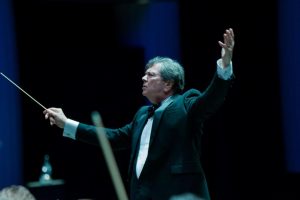
By Dennis D. Rooney
The year 2020 is the 250th anniversary of the birth of Ludwig van Beethoven, so we’re going to hear lots of his music this season.
The Palm Beach Symphony and Music Director Gerard Schwarz chose to inaugurate its 46th season with an all-Beethoven program Dec. 8 at the Kravis Center. Horacio Gutiérrez was soloist in the opening Piano Concerto No. 4 (in G, Op. 58). In the second half, the orchestra performed the Symphony No. 9 (in D minor, Op. 125), joined by a choral combination, approximately 130 strong, composed of the Palm Beach Atlantic University Oratorio Chorus, the Choral Society of the Palm Beaches, the Masterworks Chorus of the Palm Beaches, and four vocal soloists: soprano Sandra Lopez; mezzo-soprano Robynne Redmon; tenor Stuart Neill; and bass-baritone Clayton Brainerd.
In the concerto, Gutiérrez and Schwarz opted for a fluent, genial and soft-focus account that emphasized lyricism. The Fourth, composed in 1808 and first performed with the composer as soloist, was not a particular success on that occasion. It is the most intimate of the five concertos in mood, lacking the virtuosity and extroversion found in both the Third and Fifth (“Emperor”).
Its slow movement (Andante con moto) is a dialogue between piano and orchestra, likened by one commentator to “Orpheus taming the Furies,” when the piano’s eloquence gradually silences the muttering orchestra. Gutiérrez and Schwarz found the humor in the Vivace finale, which brought the performance to a satisfying close.
The Ninth is Beethoven’s final symphonic statement and also his longest, longer than any symphony written before those of Anton Bruckner, with a choral finale that sets portions of Schiller’s Ode to Joy (An die Freude).
We have it to thank for the average length of the compact disc. Sony executive Norio Ohga insisted that the new sound carrier then under development must have a playing time that would contain the entire Ninth Symphony.
Because of its monumentality and character, the Ninth has acquired a performance history associated with dedications, commemorations and other solemn occasions. Many people who know the tune of the finale’s “Ode to Joy” know nothing of the first three movements, each about 15 minutes in length, which is why audiences often grow restive sitting through them waiting for the familiar parts to arrive.
The first two movements explore the composer’s everlasting interest in kinetic energy and dramatic intensity. Both are in D minor, but the latter, a scherzo, has a rustic trio in D major. The third movement (Adagio molto e cantabile), a set of variations on two themes, is in the key of B-flat. Its tranquil close is suddenly shattered by a sharp dissonance in which B-flat and D minor chords are sounded together to announce the finale, which itself has been likened to a self-contained four-movement symphony.
The scale and complexity of the work has always challenged its performers. The Palm Beach Symphony, its conductor and assisting artists can all be praised but the performance nevertheless sounded at least one rehearsal shy, with the exception of the choruses, which sounded thoroughly prepared. Beethoven’s writing for solo voice is notoriously difficult and often unidiomatic.
Brainerd, who sang “O Freunde, nicht diese Töne!” with vocal plenitude and eloquence, also had some skimpy low notes. Neill did not phrase very lyrically but was successful in mastering all the required pitches. Lopez and Redmon were mostly able to skirt the hazards Beethoven set for them.
Schwartz led a workmanlike orchestral account that was deficient in articulation and strangely lacking in dynamic contrast. The double-dotted rhythms of the first movement were mostly smoothed out and the strong rhythmic accents in the score were also tamed unappetizingly. Much of the Adagio went well, although a tendency to rush rhythms upset its tranquility.
The aforementioned B-flat/D minor dissonance was admiringly called by Richard Wagner the Schreckensfanfare — a fanfare of terror; however, in this performance it produced no such terror, merely a slight puzzlement. But after all, it was the “Ode to Joy” that everyone wanted to hear and it made its full effect despite transient faults.